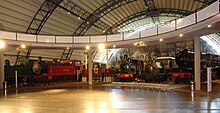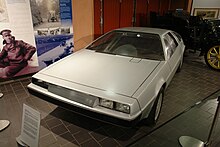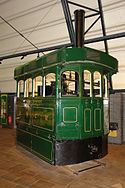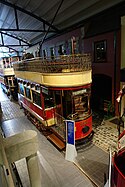Ulster Folk and Transport Museums
 Rail Gallery of the Ulster Transport Museum | |
| Established | 1967 |
|---|---|
| Location | Cultra, Northern Ireland |
| Coordinates | 54°39′02″N 5°47′55″W / 54.6506°N 5.7986°W |
| Visitors | 146,425 (2018)[1] |
| Website | |
The Ulster Folk and Transport Museum is situated in Cultra, Northern Ireland, about 11 kilometres (6.8 mi) east of the city of Belfast. It comprises two separate museums, the Folk Museum and the Transport Museum. The Folk Museum endeavours to illustrate the way of life and traditions of the people in Northern Ireland, past and present, while the Transport Museum explores and exhibits methods of transport by land, sea and air, past and present. The museum ranks among Ireland's foremost visitor attractions and is a former Irish Museum of the Year.[2] It is one of four museums included in National Museums Northern Ireland.[3][4]
History
Created by an Act of Parliament in 1958, the Folk Museum was created to preserve a rural way of life in danger of disappearing forever due to increasing urbanisation and industrialisation in Northern Ireland. The site the museum occupies was formally the Estate of Sir Robert Kennedy, and was acquired in 1961, with the museum opening to the public for the first time three years later in 1964. In 1967, the Folk Museum merged with the Belfast Transport Museum, to form the Ulster Folk and Transport Museum. The museum's Rail and Road Galleries were opened in 1993 and subsequently expanded in 1996. In 1998, the Ulster Folk and Transport Museum merged with the Ulster Museum and the Ulster-American Folk Park[5] to form the National Museums and Galleries of Northern Ireland, now National Museums Northern Ireland.
The Folk Museum


The Folk Museum houses a variety of old buildings and dwellings which have been collected from various parts of Ireland and rebuilt in the grounds of the museum, brick by brick. 170 acres (0.69 km2) are devoted to illustrating the rural way of life in the early 20th century, and visitors can stroll through a recreation of the period's countryside complete with farms, cottages, crops, livestock, and visit a typical Ulster town of the time called "Ballycultra", featuring shops, churches, and both terraced and larger housing and a Tea room. Regular activities include open hearth cooking, printing, needlework, and traditional Irish crafts demonstrations. All these new developments have aided UFTM in developing a new visitor base and have gained the site international recognition.
The museum is the holder of Northern Ireland's main film, photographic, television and sound archives. The museum holds the BBC Northern Ireland archive of radio and television programmes, and also possesses over 2,000 hours of sound material broadcast between 1972 and 2002 by the Irish language radio station RTÉ Raidió na Gaeltachta, from its studios in Derrybeg, County Donegal. The museum also maintains an archive of Ulster dialects, and a large library containing over 15,000 books and periodicals. The archives and library are open to the public during office hours.
The Transport Museum

The Transport Museum houses an extensive transport collection, and endeavours to tell the story of transport in Ireland, from its early history to the modern era. It is the largest railway collection in Ireland.[6]
The Irish Railway Collection tells the story of over 150 years of railway history. Steam locomotives, passenger carriages and goods wagons are combined with extensive railway memorabilia, interactive displays and visitor facilities. One of the collection's main attractions is Great Southern Railways Class 800 locomotive No. 800 Maeḋḃ, one of the three largest and most powerful steam locomotives ever to be built and run in Ireland.[7]

The new Road Transport Galleries boast a large collection of vehicles ranging from cycles and motorcycles to trams, buses, and cars. One of its most famous attractions is a DMC DeLorean car, the model made famous by Back to the Future, and manufactured by the DeLorean Motor Company in Belfast.
The museum boasts a permanent Titanic exhibition, documenting the construction, voyage, and eventual sinking of the ill-fated vessel. The ship has long been associated with Northern Ireland, as it was constructed in the Harland and Wolff shipyards, just a few miles from the museum. The newly refurbished Titanic exhibition, tying in with the Folk museum's 'Titanic Trail' is titled TITANICa.[8]

Another exhibition at the Transport Museum is X2: Flight Experience, developed in partnership with Bombardier Aerospace, owners of the Belfast-based aerospace company Short Brothers. Also on display at the museum is the Shorts manufactured Short SC.1, an experimental vertical take-off aeroplane, only two of which were ever produced. The example in the museum, XG905, crashed in 1963, ending up upside down and killing its pilot. It was, however, repaired and flown again before eventually being preserved by the museum.[9]
Attractions in the grounds themselves include a model railway operated by the Model Engineers Society of Northern Ireland. The model engineers give train rides to thousands of children and adults every year free of charge. A small donation helps the Society to pay for fuel for the trains. This facility is a great asset to the transport museum and enjoyed by many thousands of visitors every year who keep returning to the museum and avail of this model railway experience. There is the 120 ton steel schooner Result. Recent additions to the collection include a full set of Stanley Woods racing memorabilia, and two of his bikes. Also on display is a Rex McCandless vehicle and an early Formula 1 racing car. A little known fact of which there are examples in the museum is that the pogo stick was invented in Comber, County Down. Previously used by local potato farmers to make holes for planting their seed it was later developed by local inventor Archibald Springer who saw potential for its use as a mode of transport and sporting novelty.
Railway & Tramway Vehicles
| Number | Type | Build Date | Photo | Original Operator | Gauge | Notes |
|---|---|---|---|---|---|---|
| 47 | 6-Wheeled Director's Saloon | 1844 |  |
MGWR | 5 ft 3 in (1,600 mm) | William Dargan's private saloon. |
| 1 | Bogie Tricomposite Carriage | 1882 | CDRJC | 3 ft (914 mm) | Used as Director's Saloon when required. | |
| 2 | 4-Wheeled Bench Wagon | 1882 | Guinness | 3 ft (914 mm) | 1 of 4 built for giving tours of the brewery. Converted to 3' from 1'10. Being restored in the museum stores. Not on display. | |
| 3 | 4-Wheeled Bench Wagon | 1882 |  |
Guinness | 3 ft (914 mm) | 1 of 4 built for giving tours of the brewery. Converted to 3' from 1'10. |
| 381 | Horse-Drawn Tram | 1883 |  |
GNR | 5 ft 3 in (1,600 mm) | Fintona tram. |
| 2 | 0-4-0T Steam Tram | 1883 |  |
Portstewart Tramway | 3 ft (914 mm) | Vertical Boiler |
| 2 | Electric Tram | 1883 | GCT | 3 ft (914 mm) | ||
| 5 | Electric Tram | 1883 | GCT | 3 ft (914 mm) | ||
| 4 | 6-Wheeled Composite Carriage | 1884 | CVBT | 3 ft (914 mm) | ||
| 2 | 4-4-0T Steam Locomotive | 1884 |  |
CLR | 3 ft (914 mm) | Named Kathleen |
| 2 | Electric Tram | 1885 |  |
BNT | 3 ft (914 mm) | |
| 118 | Horse-Drawn Tram | 1885 |  |
Belfast Street Tramways Co | 4 ft 8+1⁄2 in (1,435 mm) | [10] |
| 5 | Bogie Composite Carriage | 1887 | CLR | 3 ft (914 mm) | ||
| 1 | 0-6-0T Steam Locomotive | 1891 |  |
LPHC | 5 ft 3 in (1,600 mm) | |
| 93 | 2-4-2T Steam Locomotive | 1895 |  |
GNR | 5 ft 3 in (1,600 mm) | Named Sutton |
| 4 | Electric Tram | 1901 |  |
GNR | 5 ft 3 in (1,600 mm) | Howth tram. |
| 30 | 4-4-2T Steam Locomotive | 1901 |  |
BCDR | 5 ft 3 in (1,600 mm) | Last BCDR locomotive in existence |
| 249 | Electric Tram | 1905 |  |
BCT | 4 ft 9 in (1,448 mm) | [10] |
| 20 | 0-4-0T Steam Locomotive | 1905 |  |
Guinness | 1 ft 10 in (559 mm) | In 1882 Samuel Geoghegan, the Guinness brewery's young Head Engineer invented and patented a lightweight steam engine with all moving parts high above the dirty floor to fit within a 6 ft (1.8 m) loading gauge. |
| Model of Haulage Wagon |  |
Guinness | 5 ft 3 in (1,600 mm) | Samuel Geoghegan invented also a Haulage Wagon by which his patented narrow gauge locomotives could be used on broad gauge track. | ||
| 1 | Petrol Railcar | 1905 |  |
CDRJC | 3 ft (914 mm) | Nicknamed The Pup. |
| 2 | 0-4-0T Steam Locomotive | 1906 |  |
Larne Aluminium Works | 3 ft (914 mm) | |
| 1 | 6-Wheeled Composite Carriage | 1909 | DNGR | 5 ft 3 in (1,600 mm) | Last DNGR vehicle in existence. | |
| 2 | 2-6-4T Steam Locomotive | 1912 |  |
CDRJC | 3 ft (914 mm) | Named Blanche |
| 246 | 4-Wheeled Petrol Mechanical | 1916 |  |
War Department, later sold to Carnuff Quarry of Howden Brothers in Larne and then moved to Collin Glen brickworks in Belfast | 2 ft (610 mm) | This was one of 40 bespoke Simplex petrol locos ordered in 1916 by the War Department from the Rail & Tram Car Company of Bedford for use on the trenches railway. In all, the Motor Rail Company supplied 820 locos to the War Department. |
| 74 | 4-4-0 Steam Locomotive | 1924 |  |
NCC | 5 ft 3 in (1,600 mm) | Named Dunluce Castle |
| E | Railbus | 1928 |  |
GNR | 5 ft 3 in (1,600 mm) | |
| 3 | Carriage | 1926 |  |
CDRJC | 3 ft (914 mm) | Former 5 ft 3 in (1,600 mm) railcar from DBST, bought by CDRJC and converted to 3'. |
| 11 | Diesel Locomotive | 1928 |  |
CDRJC | 3 ft (914 mm) | Named Phoenix. Built as a steam locomotive but converted to diesel in 1932. |
| 357 | Electric Tram | 1930 |  |
BCT | 4 ft 9 in (1,448 mm) | [10] |
| 10 | Diesel Railcar | 1932 |  |
CDRJC | 3 ft (914 mm) | The first articlated diesel railcar in Ireland. Ordered in 1932 by the Clogher Valley Railway as CVR railcar No 1 from Walkers of Wigan. To save money, CVR supplied the rear used carriage bogie. |
| 48 | 4-Wheeled 3rd Class Carriage | 1838 |  |
DKR | 5 ft 3 in (1,600 mm) | Built as 4 ft 8+1⁄2 in (1,435 mm), converted to 5 ft 3 in (1,600 mm) in 1856. |
| 800 | 4-6-0 Steam Locomotive | 1939 |  |
GSR | 5 ft 3 in (1,600 mm) | Most powerful steam locomotive to be built for an Irish Railway. Named Maeve. |
| 3127 | 4-Wheeled Diesel Mechanical | 1943 |  |
Admiralty Railway, Lisahally, Lough Foyle | 2 ft (610 mm) | The pier railway was built in 1942 and the loco delivered in 1943. During WWII, it hauled the covered wagon between land-based stores and ships at the end of the pier. |
| ? | 4-Wheeled Diesel Mechanical | 1944 | ? | 2 ft (610 mm) | ||
| ? | 4-Wheeled Diesel Mechanical | 1946 |  |
Northern Sand & Brick Company. In 1955 sold to the Ministry of Agriculture to work on the construction of the Black Braes Embankment sea defences beside Loch Foyle. Later sold to Co. Antrim to work on the new Ballyumford power station. | 2 ft (610 mm) | This Simplex loco was built by the Motor Rail Company of Bedford to be exhibited at the Royal Dublin Show in 1946. It was later bought by the Northern Sand & Brick Company for its Toome brickworks railway, where it worked until 1955. |
| B113 | BoBo Deiesel | 1950 |  |
CIÉ | 5 ft 3 in (1,600 mm) | |
| 35 | 4-Wheeled Diesel Mechanical | 1950 |  |
Guinness | 2 ft (610 mm) | This loco was one of 12 Planet diesels built for Guinness (beer) by F. C. Hibberd. It hauled side tippers for malt and spent grain, coal and cinders, and flat wagons for barrels up to 1975. |
| 102 | BoBo Diesel | 1970 |  |
NIR | 5 ft 3 in (1,600 mm) | |
| ? | Rail Bike | ? |  |
NCC | 5 ft 3 in (1,600 mm) | |
| 23642 | Brake Van | 19?? | CIÉ | 5 ft 3 in (1,600 mm) | ||
| 706 | Goods Van | 19?? | GSWR | 5 ft 3 in (1,600 mm) | ||
| 240 | Cattle Wagon | ? | SLNCR | 5 ft 3 in (1,600 mm) | Being restored in the museum stores- Not on public display. | |
| 136 | Open Wagon | 19?? |  |
CDRJC | 3 ft (914 mm) | |
| ? | Goods Van | 19?? | ? | 2 ft (610 mm) | ||
| 4-Wheeled Mining Carts |  |
Railway Connection for Visitors
Cultra railway station on the Belfast-Bangor railway line provides connections to Sydenham, Belfast Central and Great Victoria Street, Portadown and Newry in one direction and to Bangor in the other direction.
See also
- History of rail transport in Ireland
- History of Ireland (1801-1922)
- Culture of Northern Ireland
- Culture of Ireland
- National Museums Northern Ireland
Other museums
- Beamish Museum – County Durham, England
- Black Country Living Museum – Dudley, England
- List of transport museums
- Ulster Museum – Belfast
- St Fagans National History Museum – Museum of Welsh Life, Cardiff, Wales.
Notes
- ^ "ALVA - Association of Leading Visitor Attractions". www.alva.org.uk. Retrieved 28 August 2019.
- ^ Annual Report 2004 (PDF), The Heritage Council, p. 24, archived from the original (PDF) on 20 November 2007, retrieved 8 July 2008
- ^ [1]
- ^ [2]
- ^ "Ulster Folk & Transport Museum". Ulster Folk & Transport Museum. Archived from the original on 19 September 2004. Retrieved 7 November 2019.
- ^ Visit Northern Ireland website, Ulster folk and Transport Museum Holywood, retrieved 8 July 2008
- ^ Ulster Folk & Transport Museum : Learning : Schools And Colleges : Transport Galleries : Museums and Galleries of Northern Ireland[permanent dead link]
- ^ "TITANICa: The Exhibition". Ulster Folk & Transport Museum. National Museums Northern Ireland. Retrieved 26 April 2012.
- ^ WingWeb.co.uk, The full story of the Harrier "Jump-Jet" Part One, archived from the original on 28 August 2008, retrieved 8 July 2008
- ^ a b c Voice, David (2004). The Definitive Guide to Trams (including funiculars) in the British Isles (3rd ed.). UK: Adam Gordon. ISBN 1874422486.
External links
- National Museums Northern Ireland
- Museums established in 1958
- Museums established in 1964
- Education in County Down
- Railway museums in Northern Ireland
- Heritage railways in Northern Ireland
- Folk museums in the United Kingdom
- Archives in Northern Ireland
- Museums in County Down
- Open-air museums in Northern Ireland
- Transport museums in Northern Ireland
- Rural history museums in Northern Ireland
- 1958 establishments in Northern Ireland

